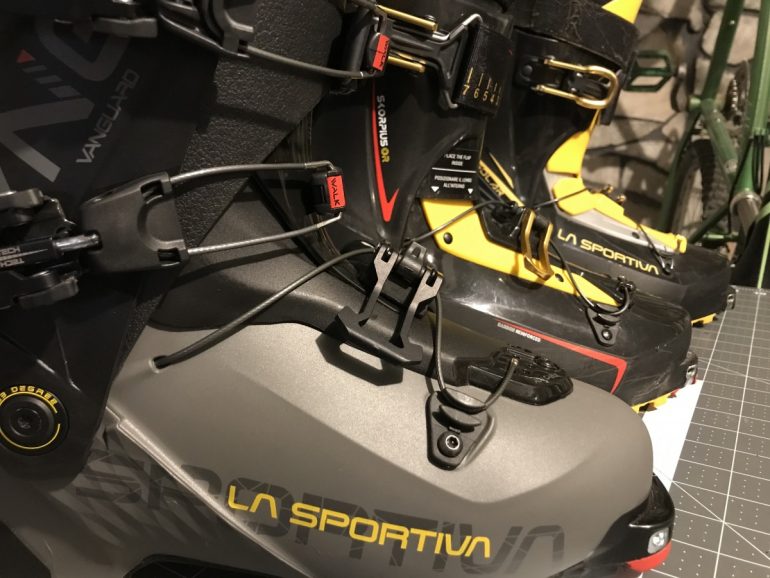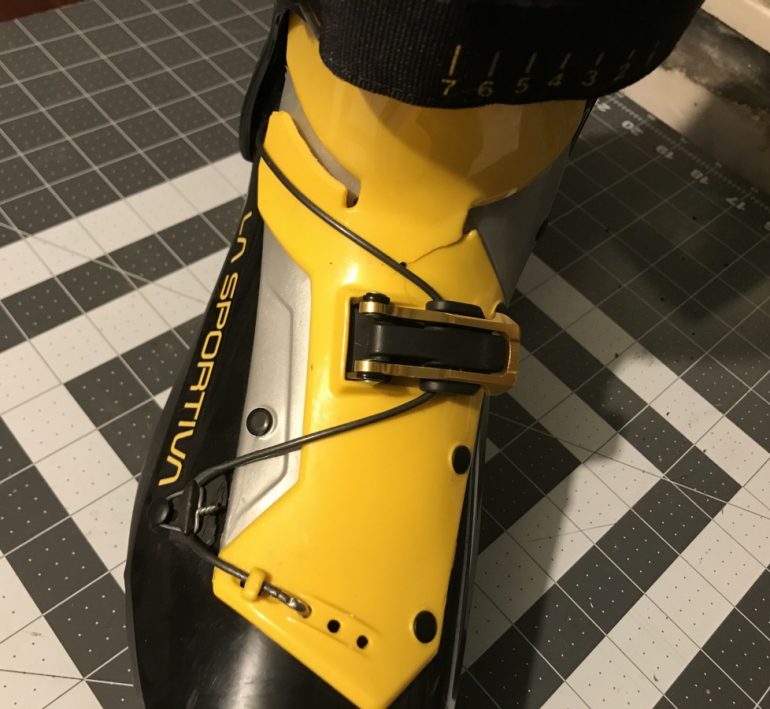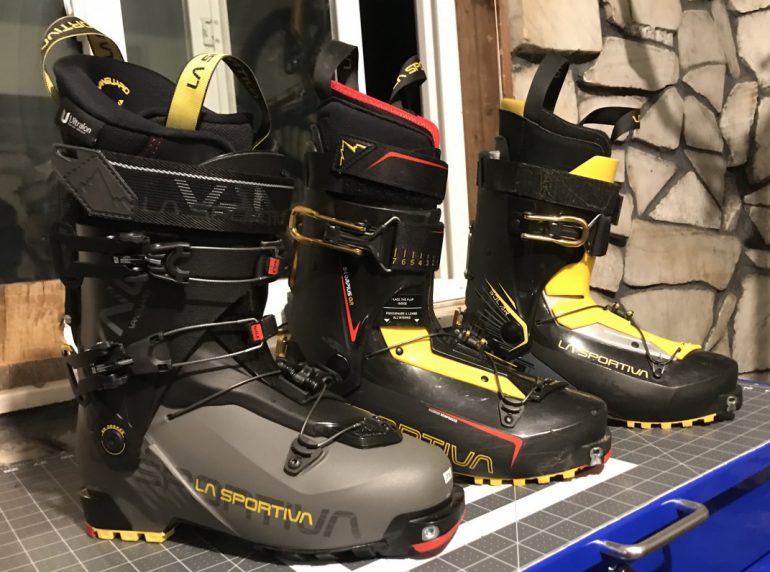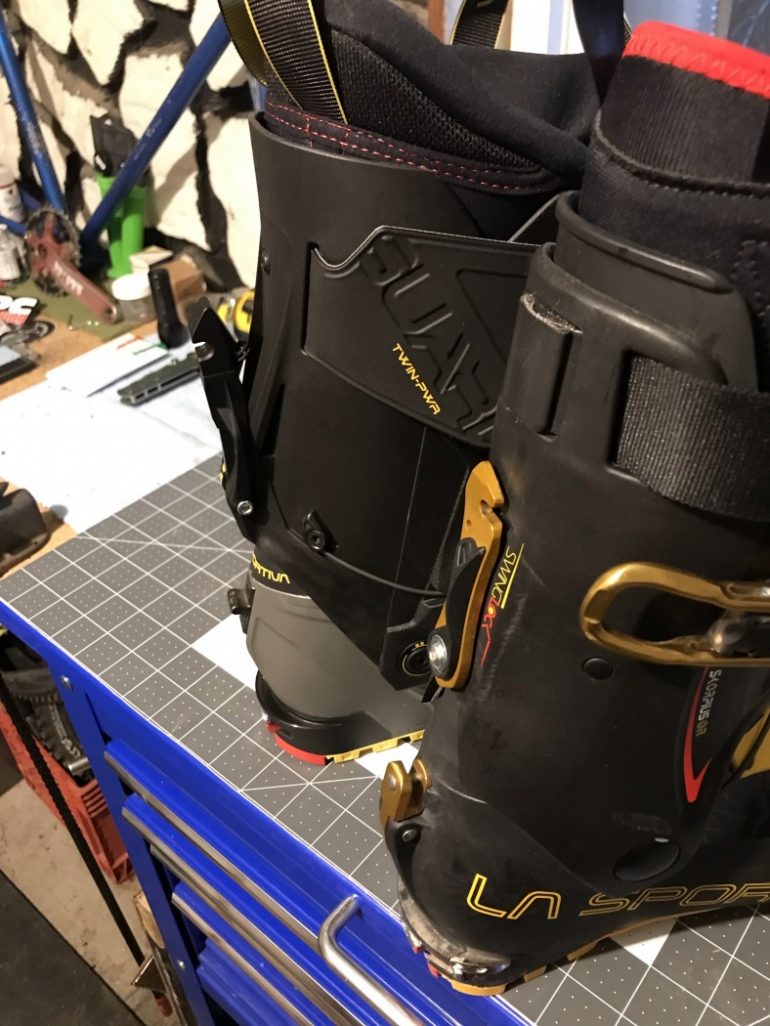
La Sportiva’s Vanguard – there’s promise for this power oriented 130 flex and a claimed 63 degree ROM boot fomr the Italien craftspeople.
Pssst… Hey, kid, want to try some boots?”
When Lou offered me a set of La Sportiva Solar boots two years ago to test, I was just another gravity-loving bro with enough dirtbag principles to be unsettled by the resort experience and drawn to exploring. I was not unused to the experience of hiking my bike up a slope to hit some desert lines, so I never questioned that uphills were simply a sad part of the equation of human-powered skiing.
The Solar (followed by the updated Skorpius) re-defined my expectations of how lightweight efficiency can improve the ski touring experience. The quick, streamlined transition process, svelte profile, and effortless range of motion made me feel I had gained cyborg powers rather than booting up for a long walk off a short pier.

The texture of the Vanguard’s plastic deviates from the smooth-feel shiny look of the Skorpius and Solar.
In the past few seasons, my late-blooming ski career skills have crept to the upper end of intermediate, and I have begun to cast an eye towards steeper, more advanced terrain. The limitations of lightweight ski mo gear become more apparent, and I find myself drifting back to accepting limitations on uphill performance to gain some more downhill confidence.
With the prospect of a more aggressively oriented ski and binding on my horizon for this winter, I knew I would need a burlier boot than the Skorpius to do the skis justice by giving myself a broader envelope of performance in the boot. Even as I anticipate elevating my skiing game, I am reluctant to accept the tradeoff of a less-efficient uphill.
The Lotus Blossoms
Before receiving these boots, I read through Doug’s First Look piece and admittedly skimmed right through the article in my new bias as a closet ski-mo junkie straight to “Yeah, but how well does it uphill?”
I totally missed out on all his allusions to the Escher Lotus cabrio tongue construction until I unboxed the boot to carpet test. Fortunately, I was sitting down because a protracted and profound moment of “Huh……” overcame me as the alien creation opened up. Pictures don’t quite do justice to how multi-dimensional the overlapping shell system is. It’s not the brilliantly simple system you look at and wonder, “why didn’t I think of that?” Each component is simple enough, but there is a tessellated aspect to how they all work together. This boot is the only ski boot I would describe as having ever truly “slipped” my feet into (even more manageable than the Skorpius). More impressive is how seamlessly all the shell layers fall into their appropriate positions without hanging up on each other or arranging into the wrong place. It’s like perfect boot-engineer origami.

The interweaving overlap doesn’t come across well in pictures, but with the boot splayed open in front of you, it is sure to inspire a moment of pondering.
The overlap on the Skorpius / Solar tends to “explode” apart in the process of inserting your foot. It takes a bit of careful attention to layer the shell back correctly. I believe my Solars suffered cracking due to fastening the shells together incorrectly during hurried trailhead transitions, concentrating undue stress on the tongue.

A ham-fisted buckling attempt snapped off part of the Z-cable anchor. The safety wire fix has been holding, though the boot has been relegated to xc touring duty.
Carpet testing Comfort
Like Doug, I couldn’t help but think that all the overlapping layers would contribute to a noticeable increase in friction. Yet, in a side-by-side test of the Skorpius and Vanguard involving walking around the garage and up and down our split level stairs, it took close attention to discern the difference between the two. The Skorpius has slightly more freedom of movement in the ankle and a noticeable few degrees more range in rearward motion. I anticipate it is the sort of difference that would evaporate in a few strides from the truck.
Locked into ski mode, the difference between the two was far more substantial. The Skorpuis has a very noticeable few mm of “free play” before the support of the tongue engages, while the Vanguard has a much more immediately engaged feel.
Just as significant as the difference in shell construction, the Vanguard‘s liner is significantly beefier than that of the Skorpius. Out of curiosity, I tried stuffing the Vanguard liner into the Skorpuis to see if I could create a hybrid combo. Despite the larger Skorpius last, listed at 102mm, and the Vanguard at 98mm, the Vanguard liner’s last is far too bulky to fit in the svelte shell of the Skorpius. Despite the difference in last sizes (a 4mm range), I couldn’t tell the difference in side-by-side carpet testing.

The Vanguard is the most “freeride touring” oriented boot in the La Sportiva lineup. In addition to being noticeably bulkier than the Skorpius / Solar platform, and has a textured matte shell v. the high gloss finish of the ski-mo oriented boots. Shiny boots have to be faster up hill, right? The Vanguard also utilizes traditional toe tech fittings (presumably for better retention characteristics, v the Quick Step (?) easy entry fittings on the Skorpius / Solar.
More so than the quantitative difference between the three buckle design of the Vanguard and the two buckle design of the Skorpius is the way the buckles function. The upper two buckles on the Vanguard are a traditional catch & bail system that require fully unbuckling to access touring mode, and the lower buckle is a two-wire Z system. The rear latch swings out at a right angle to the boot, a la everybody else.
The Skorpuis has a single wire lower Z buckle, and the upper buckle is a combination velcro power strap and compound cam buckle that lays nearly flat against the boot when open. Combined with the Swing Lock rear buckle, the Skorpius provides the most seamless and hassle-free transitions I have ever experienced.
Impressive as the carpet testing mobility of the Vanguard has been, the catch & bail buckles and pant-snagging rear latch are sure to add a degree of fumbling to transitions that the elegant Skorpius does not possess. With the armchair engineer in me as it is, I can’t help but already fantasize about a Vanguard with dual Skorpius straps and Swing Lock.
Post-production fantasies aside, most important to me is that the Vanguard so closely mimics the luxurious stride of the Skorpius that I’m willing to take a little more hassle on the transition if it yields an increase in downhill skiing as promised in the carpet test.
Specs from Stenclik’s first Look:
Mass: 1515g (27.5) confirmed
(Updated) Last width: 102
ROM: 63 degrees
Flex: 130
(Updated) Forward Lean: 12 degrees (Default), but can be adjusted to 14 degrees
Sole: Tech Gripwalk Pads
Buckles: 3-buckle (1 z-buckle), power strap
UPDATED 12-20-21 Binding Compatibility: Tech bindings and other AT bindings. From La Sportiva – “The Vanguard is built to the specifications for ISO 9523 standards, and the certification is in process.” … “from a liability perspective, the Vanguard is not currently certified to reliably release from bindings with Gripwalk/ISO 23223 certifications.”
Aaron Mattix grew up in Kansas and wrote a report on snowboarding in seventh grade. His first time to attempt snowboarding was in 2012, and soon switched over to skis for backcountry exploration near his home in Rifle, CO. From snow covered alleys to steeps and low angle meadows, he loves it all. In the summer, he owns and operates Gumption Trail Works, building mountain bike singletrack and the occasional sweet jump.

